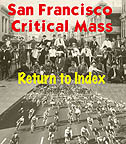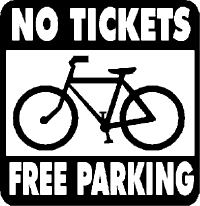

by Chris Carlsson, August 1993
Critical Mass began rather unassumingly, under a less catchy name, the Commute Clot. I went to a SF Bike Coalition meeting in August 1992 and suggested—since there were so many people on bikes downtown, and conditions where so infamously bad—that we gather once a month, make our presence felt to ourselves and the rest of the city, and ride home together. An enthusiastic response was followed within a few weeks by the SFBC's cautious disavowal of responsibility, but the idea caught on immediately. The first ride drew about 60 and after a full year it is drawing upwards of 600+ per ride.
The name Critical Mass came from Ted White's bike-umentary "Return of the Scorcher" wherein intersection crossing etiquette in China's big cities is discussed as a matter of Critical Mass: the cross traffic waits until it achieves critical mass and then pushes through, leaving the original stream of traffic to stop and build until it reaches its push-through point. Once a month we are a Critical Mass, filling 3-4 long blocks of San Francisco's Market Street at the tail end of rush hour, and pedalling in a free-expression zone temporarily free of engines and exhaust.
It was easy to organise CM because it's based on what people do already (bike commute along a main corridor), and its main declared purpose is to enjoy our presence and each other's company as we ride home together. It was also easy because without a specific agenda or organisational sponsor, no one had to actually agree with anything beyond a vague enthusiasm for bicycles, and that leaves room for a pretty wide range of people. Critical Mass has, in fact, brought a lot of new people into contact with each other. The basis for many other initiatives has already been laid, and the lived experience of a vibrant public life, at least for short times, has been tested by thousands of people.
Participation in an event without the usual trappings of monitors and organisers doesn't mean that there can be no preparation or safety measures. In fact these issues are just as important as ever, since the nature of the ride means it's very possible for someone to get hurt in a fall or in the worst case, by an irate psychotic in a car. In San Francisco we developed a few useful devices that help defuse bad moments and keep the ride moving along comfortably. In fact, the vast majority of people we pass give us thumbs up and friendly waves as they marvel at our procession.
Of course there is the occasional pissed-off macho car driver who manages to get the attention of one or more spoiling-for-a-fight-been-run-over-three-times-this-week bicyclists and before you know it things can get very out of hand. Luckily, cooler heads have always prevailed so far. On the April 1993 ride, a bad scene occurred at the back of the ride as it straggled up Market Street. Too few bicyclists were holding the intersections as the slowpokes made it through, after motorists had already been waiting for a while. An impatient man in an Audi pushed his way into the bikes, knocking one guy over. He got up and out of the way with his bike, basically unhurt. Then the driver lunged forward suddenly and smashed into Rebecca Seybold - she went flying, her bike under the wheels. The driver freaked out and tried to drive away, but Rebecca's bicycle jammed his steering and he got stuck in a long futile U-turn ending on the southwestern corner of Guerrero and Market. Meanwhile 20-30 bicyclists surrounded his car and as he drove away they began pounding on it with their locks, smashing a couple of windows. Rebecca's boyfriend John Kelly jumped through a broken window and grabbed the keys out of the ignition. The cops charged him with battery and Rebecca with malicious mischief, and characterised the motorist as the victim. On September 17, four months later, all the charges were dropped.
The East Bay Critical Mass ride, which takes place on the second Friday of each month, beginning at the downtown Berkeley BART station, took a somewhat different path. Without an obvious commute corridor like SF's Market Street, it became an unpredictable ride, careening around the East Bay, ultimately visiting the inside if a Safeway as well as a few McDonald'ses on its way to a rendezvous with the California Highway Patrol after a cruise down a couple of miles of Interstate 80 along the East Bay shore. Since the 63 arrests that day, a concerted effort has been made to calm the East Bay ride, and pursue a more long-term subversive strategy in the same vein as San Francisco's, downplaying the adolescent confrontations as much as possible. But the individual politics of the participants will always be heterogeneous, with militant punk anarchists and Clintonesque corporate workers riding side by side.
Pat Buchanan invoked a 'Culture War' during the last presidential campaign, and the past decades' confrontations between religious fundamentalism and secular liberal traditions is part of that. But the numerous alternative subcultures that flourish in San Francisco have their own agenda, outside of that war. When we ride along, several hundred strong, hooting and hollering, whistling, laughing and singing, past boutiques laden with furs and jewellery near Union Square, it feels like a coup, a clever tactical strike, in our kulturkampf. But our alternative culture has to go beyond mere moral guilt about excess consumption and really present a wholistic alternative involving the totality of daily life, from the work we do to how we get around and how we treat each other. Many of the pieces of that puzzle are already well developed but systematically thwarted by the way life is organised now. We know it can be very different, and when we're on the streets together we can feel it and see it.